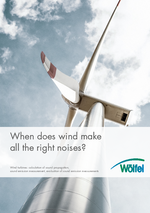Sound Emission Measurements and Measurements for Acceptance Tests according to IEC 61400-11 and FGW Guideline | Sound Source Localization with the Acoustic Camera
Wind turbines generate sound and thus emit acoustic noise. In the course of the turnaround in energy policy, new locations for wind turbines have to be found and there is a huge potential for conflict due to noise pollution.
We offer services and product solutions covering the entire wind turbine approval procedure, from noise impact prediction in the planning phase to acceptance measurement following the commissioning of a wind turbine.
Sound Emission Measurements and Measurements for Acceptance Tests according to IEC 61400-11
- As part of the approval of your wind park under immission control law, you want to verify the compliance with sound power levels and document their correct determination?
- The newly developed prototype of your wind turbine requires the measurement of acoustic emissions as a basis for the type certification?
As a member of the Fördergesellschaft Windenergie (FGW e.V.) (Society for the Promotion of Wind Energy) we perform measurements of emitted acoustic noise and measurements for acceptance tests according to IEC 61400-11 and FGW guidelines. Sound immission control particularly deals with questions of noise propagation outdoors. The objective is to ensure compliance with limit values (Technical Instructions on Noise Abatement) in order to protect the people in the vicinity.
The central success factor for sound emission measurements is a fast reaction time under favorable wind and weather conditions. With branches in Höchberg near Würzburg, Hamburg and Berlin, we can carry out measurements flexibly and efficiently in both southern and northern Germany.
The efficiency of our measurements has also significantly increased with our wireless measuring system RoBin (link to Tab): The time from our arrival at the wind turbine to the start of the measurement is only about 30 minutes due to the simple setup. For example, several wind turbines and several operating modes can be measured in accordance with standards on one measuring day.
Sound source localization with the acoustic camera Noise Inspector
- You want to know exactly which parts of the wind turbine increase the noise level or cause tonalities? You also want to know how these tonalities can be eliminated?
In order to be able to plan and initiate noise abatement measures, it is necessary to know the exact source of the noise. We have various measuring systems to cover almost all cases. The acoustic camera Noise Inspector locates sound sources and displays the results as an acoustic photo or video.
We support you when you are confronted with acoustic issues – whether you just have to locate a sound source or want to develop noise abatement measures.
Our references in the area of sound source location (extract):
- Rhein Energie AG
- GE Wind Energy GmbH
- Enercon
- Vensys Energy AG
- MAC Energysystems GmbH & Co. KG
Please contact me personally
________
I will be happy to advise you on questions regarding our system and service offerings in the areas of sound and noise.

Dr. rer. nat.
Daniel Höhne-Mönch
Consulting engineer
+49 931 49708-333
hoehne-moench@woelfel.de
Contact form
Physics
Doctorate/Dr. rer. nat.
DIN Standards Committee 005-55-70 AA Sound insulation in urban development
The varied work. No day is like the other.




![[Translate to English:] [Translate to English:]](/fileadmin/_processed_/9/a/csm_Windenergie_01_Schall-laerm_1000_875_a53e13e186.jpg)



![[Translate to English:] [Translate to English:]](/fileadmin/_processed_/e/e/csm_Windenergie-SHM-Blade-Onshore-Kachel_2a42f3422c.jpg)